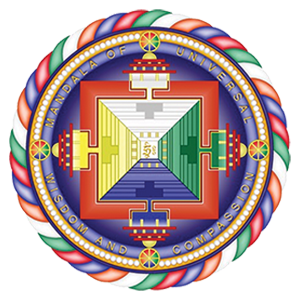by Leigh Miller, PhD
(Spring 2024)
… These were the gifts of grief … And yet, the experience has also deepened my capacity to touch grief–my own, and others’ –in my clinical work as a Chaplain …
In my second unit of clinical pastoral education (clinical chaplaincy training), I had many opportunities to reflect on being a Buddhist, a mother, and on some experiences with death and grief. I had already been a Buddhist for almost 30 years, and a mother for almost 15 years. In the care of midwives, I gave birth naturally to two children, now ages 13 and 15. Between those two extraordinarily healthy pregnancies, I suffered a miscarriage. The thoroughly overpowering, singularly focused sorrow and loss that blew through me was shocking in its power, far beyond what I could have expected to grieve after less than two months of pregnancy. Part biology and hormones, part investment in the meanings I was starting to construct for this new life, this grief experience gave sobering depth to “motherhood”. In my bones, my two living children are inconceivably precious to me. I recall their early childhoods with much tenderness and wonder, remember the frustration and exhaustion of navigating it as a single working mother in graduate school, and marvel at their unfurling personhood. In our everyday routines these days, I rarely recall that miscarriage, but there are other reminders that my children can die at any time: school shootings, teen suicides and overdoses on the rise, car accidents….and yet, I still do not really think, every day, that today, any day, might be the last one I ever see, hold, hear, smell, hug my child. I don’t think this way about the lives of my friends and my loved ones: every time I see them and then say ‘goodbye ‘til next time,’ it could actually already be for the last time. Nor do I think I, myself, could die even before the end of this day, even though I know, intellectually, we will all die one day, and none of us know the manner or time of death. (This is a point Buddhists intentionally contemplate to urge making the most of this precious lifetime while we have it.)
Despite all the dharma teachings of death and impermanence I have heard, it was a jarring shock to my emotional and spiritual life to be accosted by sudden grief at the drowning death of a beloved close friend, whom I’d so casually had dinner with a week before. Without warning, I became part of a circle of shocked, bereaved, tearful people, newly forming community around our common loss, my heart open and tender to each of them, and everyone who was mourning, the world over. That humans so often compound, rather than alleviate, suffering in the precious lives of all beings felt unbearable. Knowing that anyone I encountered could be reorienting to life lived with deep losses, compassion and love and gratitude became even more compelling ways to be in the world. These were the gifts of grief, which isn’t to say the world wasn’t dimmer and my life running on dull autopilot for a long time, too. And yet, the experience has also deepened my capacity to touch grief–my own, and others’ –in my clinical work as a Chaplain.
One such moment I will long remember is the mother who tucked in her precious three-year old boy, a blond-haired angel, under a comfort quilt and kissed him goodnight for the last time.
I responded to a page to a Pediatric Code Blue arriving at the ED in four minutes, in the late afternoon of a summer holiday. The EMTs were bringing in a boy who’d been reported missing by his father, and then found some hours later in the pool in their backyard. It was unknown how long he’d been without a pulse or breathing; they began working on him in the ambulance and continued in the ED with chest compressions, injections, intubation…a whole crisis team calling out, counting down, and coordinating their interventions to the second, and clearly carrying on like this longer than they had any hope of revival behind their actions. I was sent to the waiting room to catch the boy’s mother, who’d been called at her workplace. She frantically burst in, and collapsed to the floor, but would have nothing to do with me. I was bearing a “Chaplain” badge that implied that her boy must be already dead, and she was desperate for hope, for him to be alive. Nurses helped lift and walk her to the waiting room, where we were briefly updated –“we are working on him”–by a wise female physician, who offered to bring Mother to her child’s room. This terrified mother frantically wanted to be at his side, so we entered the room with this crisis team still hard at work. I stayed with Mother for most of the next four hours, as resuscitation efforts ceased, and she scooped up her child to cradle him in her lap for as long as possible. Family members started arriving in a steady stream. One sister was immensely supportive, efficacious, and loving. The father was guilt-ridden, anguished, and barely able to stay in the room next to his wife and child. Mom’s own father showed his heartache at his own loss of a beloved grandchild, and empathy, as a parent himself, for his daughter’s torment, and offered his stalwart steadiness of presence. Another sister had been off-duty for the holiday and had previously started drinking and came in to the ED room combative and furious. A young niece working in a hospital unit upstairs came in–uniformed, stunned, and non-verbal. Friends in the waiting room coordinated care for the other children at home and communicated with relatives out of town. Everyone was devastated.
Knowing that every person expresses and navigates crisis and grief in their own ways, I wanted to facilitate meeting their spiritual and emotional needs and wishes, but they were too shocked and gutted to answer questions about what those might be. I recognized, from my own experiences, the speechlessness of an awful reality that cannot be grasped and cannot be undone. I also needed to protect them from intrusion from anyone that they may not have wanted in the room, and so continued to ask for consent to bring in each new relative or friend who arrived. The child’s mother once feebly voiced, “if they want to say goodbye, they can come in, as long as I don’t have to move from him.” I looked for permission from her sisters, husband, and her father after that.
I knew the parents couldn’t ask about what would come next in hospital protocol, but would need to be guided through it, so I gathered procedural information for pediatric deaths from other ED and spiritual care staff, the county coroner, and a chaplain with the Sheriff’s office. I knew then the procedures, and how long the family could stay. It became clear that the physical tasks were the other hospital staff’s domain; supporting the family navigating their spiritual and emotional and interpersonal dynamics was up to me. I selected a colorful, child-sized bereavement quilt, and after the county coroner completed her exam with mom out of the room, spread it on him and stayed by his side until she was allowed back in; as a mother myself, I think she appreciated that her boy had never been alone. I found a small, heart-shaped pillow with a pocket sewn on the back, into which a nurse placed a lock of his golden hair.
Mother said, “I am going to hold, smell, and touch my baby for the last time for as long as I possibly can.” And she did. She barely looked up from him and was not ever going to be “ready” to leave. I invited the father’s telling of the child’s love of dinosaurs, how smart he was to have learned all their scientific names, how his funny and sweet ways lit up every room. Mother smiled and added that her boy was always kind, polite, and adorable, saying things like, “Mama, may I have another muffin, please?” All of us, staff and relatives, had tears in our eyes, standing in the doorway, hallway, or in the room. Gradually, though, we were approaching the most generous edge of the coroner’s timeline for taking the child’s body from the hospital to the country morgue. I placed a hand on Mother’s shoulder and said we could pray as her angel left her arms and was welcomed lovingly into God’s. She didn’t respond for a few long minutes. Then she stood and placed his body from her lap onto the bed. Another chaplain softly said a prayer. One of the boy’s arms, which she had positioned around her neck as she had cradled him, was now stiffly raised. Tenderly, calmly, she lowered it, and tucked the quilt tightly around his torso. She kissed his forehead. I deeply know this bedtime ritual that I have done thousands of times, the ritual that assumes awakening in the morning, and all the mornings after that… This mother kissed her boy, touched his golden hair. She then turned into the arms of her husband, her legs weak, and took a faltering step towards the doorway. There was a moment’s hesitation, but she did not look back. It is the hardest thing I have ever witnessed a human do: a mother releasing her dead child.
The story of Kisagotami, from the Buddha’s time, is of a mother who refuses to let go of her deceased child. Crazed by grief, she seeks the sage and begs Buddha to bring her child back to life. He tells her that he can do such a thing, but that first she must obtain just one mustard seed. He will hold the child while she is gone. Confidently and enthusiastically, Kisagotami is about to run to the village when Buddha informs her that the mustard seed must come from a home that has never been bereaved. She accepts this condition and proceeds to knock on door after door after door. Kisagotami eventually returns empty-handed, but with a heart that has been opened to the community of the grieving, of which she is now a member. With a sad but clear mind, she sets her child on the funeral pyre.
When Kisagotami first arrived in denial and urgent distress, Buddha did not give her a sermon about impermanence, or try to make her face the truth, or tell her it would be okay; his pastoral act was to sit with her in her pain, and give her a task of mourning (though she does not yet know this) to focus her mind and move her body, from which she derived her own lessons about not being alone or the first to lose a loved one. She discovered loss and grief are an inevitable part of the human condition. From that day on, she dedicated her life to spiritual practice, becoming known for her great insight into the impermanent nature of all who live. Her story of renunciation and spiritual liberation is recorded in the book of the female elders, those accomplished spiritual adepts who were Buddha’s disciples and became teachers in the early communities of monks and nuns.
In my ministry, I knew that this mother’s grief was beyond words, beyond thought, but she could take some actions of tender care for his body and would rely upon the shared grief her close family held with her.
In the Buddhist tradition, the image of a mother’s love for her child is an oft-invoked metaphor for the kind of compassion and love we aspire to cultivate indiscriminately towards all beings, as impossible a task as that may seem. This encounter also ‘ministered’ to me, by giving me a taste of the compassion and grief I could feel for this mother, child, and family, despite them being “strangers”; it is not as hard as we imagine to expand our love beyond our friends and family to strangers (and even, as in Buddhist equanimity practices, possibly towards our so-called enemies). I placed a call to this mother just over a week later for grief facilitation, and had a tender and long conversation, about how she and her family are talking and laughing about their child daily, planning a funeral with many adorable photos, arranging support for the boy’s siblings, and how she is continuing to get up each day for the sake of her other kids. The family is in deep mourning, and their hearts may expand through love to the sorrow and preciousness of life that unites us all.


